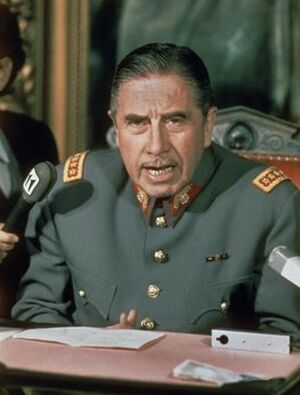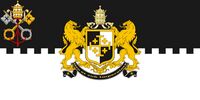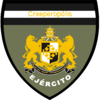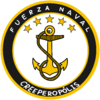National Intelligence Directorate
| Dirección de Inteligencia Nacional | |
 | |
| Agency overview | |
|---|---|
| Formed | April 26, 1933 |
| Type | Secret Police |
| Jurisdiction | Papal State |
| Headquarters | San Salvador, San Salvador |
| Employees | 50,000? c. 2010 |
| Minister responsible |
|
| Parent agency | Government of Creeperopolis |
The Dirreción de Inteligencia Nacional (National Intelligence Directorate), abbreviated DINA, is the secret police of Creeperopolis and its vassals.
The DINA is headed by the Chief of the DINA who is also the Minister of Defense.
History
Civil War



The DINA was established on April 26, 1933, during the first year of the Creeperian Civil War. It was established on orders of Emperor Romero I as a way to arrest and interrogate captured Miguelist prisoners of war. Control of the secret police was given to Minister of Defense, Adolfo Cabañeras Moreno.
Cabañeras Moreno authorized the use of any means deemed necessary to retrieve information from the prisoners being interrogated. The DINA became known across war-torn Creeperopolis as a ruthless organization that uses various means of torture to force their prisoners to speak. If a prisoner refused to speak after a month of various torture methods conducted by the DINA, they were often left to starve in their cell or executed by hanging. During the civil war, DINA members who were captured by the Miguelists were hanged without a trial.
Following the assassination of Adolfo Cabañeras Moreno, his successor, Alfonso Cabañeras Moreno, increased the torture period to two months and prohibiting hangings of prisoners stating:
"It is better to let an animal starve to death so it suffers until its last breath knowing it could have saved itself, than to give it mercy and end its misery."
Throughout the civil war, the DINA is estimated to have tortured over 30,000 prisoners, hanged over 6,000, and left over 9,000 to starve to death.[citation needed]
The DINA is believed to have the most human rights abuses committed during the civil war, second only to the death squad known as Sombra Negra.
Alfonso Cabañeras Moreno also changed the date at the bottom of the DINA logo from 1933, the year of its establishment, to 1944, the year his brother and the DINA's first Chief was assassinated.
Post-Civil War
Following the civil war, Alfonso Cabañeras Moreno continued to use the secret police as a means to weed out the final remnants of communism, socialism, and leftism from Creeperopolis. The DINA also shifted its focus to carry out operations against the Senvarian Liberation Front in the Third Senvarian Insurgency.
The DINA was brought under heavy attack and criticism by Salvadoran activists and revolutionaries during the 1956 Salvadoran Revolution. President Paúl Sáenz Mina declared that DINA presence in revolutionary El Salvador was illegal and that all DINA agents would be executed immediately upon capture without a trial. The DINA retreated from El Salvador and allowed the Creeperian Army to crush the revolution. As part of a compromise to appease the Salvadorans, Emperor Romero II agreed to withdraw the DINA from El Salvador indefinitely.
When the Mara War broke out in 1979, Chief Emmanuel Cabañeras Videla ordered the DINA to be more cruel and more violent in its interrogation methods, especially to members of the gang Mara Salvatrucha. Cabañeras Videla told his agents to be more cruel than the DINA under Cabañeras Moreno during the civil war. Torture periods were raised to one year and prisoners were to be shackled in their cells permanently, only to be released for "interrogation."
During the October 16 Regime of Alfonso VI, DINA power and influence was curbed, angering Cabañeras Videla and the entire DINA. Cabañeras Videla died on October 19, 2002. His son, Augusto Cabañeras Gutiérrez, became the new Chief of the DINA with the approval of Alfonso VI.
Cabañeras Gutiérrez plotted with the Chief Admiral of the Creeperian Navy, José Guerrero López, and the Chief General of the Creeperian Air Force, Gabriel Negrín Carpio, to topple Alfonso VI's regime and establish a military junta over Creeperopolis, essentially abolishing the monarchy. Cabañeras Gutiérrez, however, saw the Emperor's son, Alexander Martínez Hernández, as a tool he can use to gain the support of the Creeperian people to solidify his control. The 2003 Creeperian Coup D'état toppled the regime, killed Alfonso VI, and allowed Alexander II to rise to the Imperial throne.
Alexander II authorized Cabañeras Gutiérrez to use any means necessary to eliminate any remaining supporters of Alfonso VI's regime. Torture was extended to two entire years. The DINA became more feared than ever under Cabañeras Gutiérrez.
During the imposition of martial law in Creeperopolis in 2019, the DINA returned to El Salvador under the guise of "eradicating terrorism." The DINA remains there to this day despite the lifting of martial law.
Human Rights Abuses
The DINA is notorious inside and outside of Creepeorpolis for its human rights abuses.
Its record during the civil war is marked by uncountable cases of torture and execution without a trial. No DINA agents have ever been taken to court for war crimes or crimes against humanity. The DINA is also believed to be one of the most, if not the, most corrupt government agency of Creeperopolis.
Augusto Cabañeras Gutiérrez has become one of the most powerful men in Creeperopolis due to his leadership of the Army and the DINA, and he uses his essentially unchecked power to carry out whatever he wishes through the DINA without consequences for the human rights violations committed.
The DINA continues its extensive human rights violations, to, in the words of Augusto Cabañeras Gutiérrez:
"[E]radicate all traces of Communism, Atheism, Senvarian and Senvekian nationalism, and any form anti-Creeperian, anti-Catholic, or anti-Fatherland behavior, thoughts, and actions to preserve Creeperopolis and its prosperity."
Organization
Detachment A (Political Opponents)
- Communism (A1)
- Counter-Sabotage (A2)
- Reactionaries and Opposition (A3)
- Protective Services (A4)
Detachment B (Sects and Churches)
- Protestantism (B1)
- Islam (B2)
- Irreligiousness (B3)
- Atheism (B4)
Detachment C (Party Affairs)
- Files, card, indexes, information, and administration (C1)
- Protective custody (C2)
- Press office (C3)
Detachment D (Rebel Territories)
- Affairs of Senvar (D1)
- Affairs of Senvek (D2)
- Affairs of Castilliano (D3)
Detachment E (Security and Counterintelligence)
- Atlántida (E1)
- North (E2)
- Central (E3)
- South (E4)
- Castilliano (E5)
- Senvar and Senvek (E6)
- Papal State (E7)
- Salvador (E8)
- Adolfosburg (E9)
- San Salvador (E10)
- El Salvador (E11)
Uniforms
DINA agents wore plain civilian clothes so they can blend into Creeperian life. Agents only wear military uniforms at formal events.





